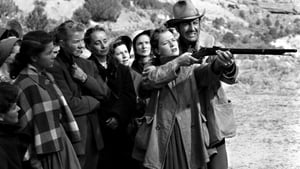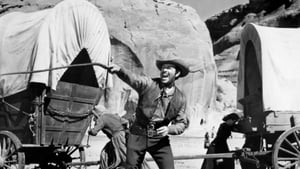Contact: [email protected]
Video Sources 0 Views
- Watch trailer
- Westward the Women


Synopsis
Table of Contents
ToggleReview: Westward the Women (1951) – An Epic Journey of Strength, Courage, and Female Empowerment

Introduction
Westward the Women, released in 1951, stands as a remarkable western drama directed by William A. Wellman. Set during the pioneering era of the American West, this film tells the captivating story of a group of women who embark on a perilous journey across the frontier in search of new beginnings. In this review, we’ll delve into the sweeping narrative of Westward the Women and its celebration of female resilience, determination, and empowerment.
Check The Full Colorized Movies List
Check Our Colorized Movies Trailer Channel
Understanding Westward the Women (1951): Director, Cast, and Genre
Directed by William A. Wellman, Westward the Women features a talented ensemble cast led by Robert Taylor, Denise Darcel, and Hope Emerson. The film falls within the western drama genre, known for its exploration of the rugged landscapes and untamed spirit of the American frontier.
Exploring the World of Westward the Women (1951): Plot and Characters
Westward the Women follows the extraordinary journey of Buck Wyatt (Robert Taylor), a trail guide tasked with leading a group of women from Chicago to California to meet their prospective husbands. As they traverse the treacherous terrain of the Old West, the women must confront adversity, forge bonds of sisterhood, and discover the depths of their own strength and resilience.
The Art of Film Colorization
While Westward the Women was originally filmed in black and white, its early colorized version adds a new layer of visual richness and vibrancy to its sweeping landscapes and breathtaking cinematography. The colorization process enhances the film’s epic scope and captures the rugged beauty of the American West, immersing viewers in the awe-inspiring majesty of the frontier with authenticity and nuance.
Early Colored Films: A Brief History
The history of early colored films is marked by innovation and experimentation as filmmakers sought to capture the natural beauty of their surroundings and enhance the visual appeal of their movies. From hand-tinted frames to pioneering technicolor processes, the evolution of colorization techniques transformed the cinematic landscape, offering audiences a vivid and immersive viewing experience.
Westward the Women (1951) and Its Early Colored Version
The decision to release Westward the Women in a colorized format was made with the intention of immersing audiences in the breathtaking beauty of the American West and enhancing the film’s epic scale. While some purists may prefer the original black and white version, the early colorized edition of the film adds a new dimension to its storytelling and captures the rugged grandeur of the frontier with stunning visual impact.
The Debate Over Film Colorization
The debate over film colorization continues to divide audiences and industry professionals alike. While some argue that colorization breathes new life into classic films and makes them more accessible to modern audiences, others maintain that it compromises the artistic integrity of the original work. As technology advances and filmmaking techniques evolve, the debate over colorization remains a topic of ongoing discussion within the film community.
Examining Westward the Women (1951) as an Early Colored Film
Viewing Westward the Women in its early colorized iteration offers audiences a fresh perspective on its sweeping narrative and timeless themes of female empowerment and resilience. The colorization process enhances the film’s epic scope and captures the natural beauty of the American West, immersing viewers in the awe-inspiring majesty of the frontier with breathtaking authenticity and nuance. As the women of the wagon train confront adversity and forge bonds of sisterhood, their journey serves as a powerful testament to the strength and resilience of the human spirit.
Influence and Legacy: Westward the Women (1951)’s Impact on Cinema
Westward the Women is widely regarded as a groundbreaking western drama that celebrates the strength, courage, and resilience of women on the frontier. Its portrayal of female empowerment and camaraderie has inspired audiences around the world and influenced the depiction of women in western cinema. As a testament to its enduring relevance, Westward the Women remains a timeless cinematic masterpiece that continues to resonate with audiences of all ages.
Director’s Cinematic Legacy: Beyond Westward the Women (1951)
William A. Wellman’s directorial legacy extends far beyond Westward the Women, encompassing a diverse body of work that explores themes of courage, resilience, and the human experience. As a filmmaker, Wellman was known for his ability to tell compelling stories with depth and authenticity, as evidenced by his masterful direction of Westward the Women. The film stands as a testament to his talent and creativity, solidifying his reputation as one of the great directors of his time.
Themes Explored in Westward the Women (1951)
At its core, Westward the Women explores themes of strength, courage, and female empowerment in the face of adversity. Through its sweeping narrative and memorable characters, the film celebrates the indomitable spirit of women on the frontier and their ability to overcome obstacles and forge their own destinies. As the women of the wagon train embark on their perilous journey, they serve as powerful symbols of resilience and determination, inspiring audiences with their unwavering resolve and pioneering spirit.
Reception and Controversy Surrounding Westward the Women (1951)
Upon its release, Westward the Women received widespread critical acclaim for its sweeping narrative, breathtaking cinematography, and powerhouse performances. However, the decision to release the film in a colorized format sparked debate among fans and critics alike. While some praised the colorization process for enhancing the film’s visual impact, others questioned its necessity and expressed concern about preserving the integrity of Wellman’s original vision.
Where to Watch Westward the Women (1951) Online
For those eager to experience Westward the Women for themselves, the film is readily available on popular streaming platforms such as Amazon Prime Video, Google Play Movies, and iTunes. Whether viewed in its original black and white format or its early colorized iteration, Westward the Women offers a sweeping and immersive cinematic experience that is sure to captivate audiences.
FAQs About Westward the Women (1951)
1. Is Westward the Women based on a true story?
No, Westward the Women is a fictionalized portrayal of a group of women who embark on a perilous journey across the American West in search of new beginnings. While the film’s characters and storyline are works of fiction, its exploration of female empowerment and resilience draws inspiration from real-life experiences and historical settings.
2. Who starred in Westward the Women?
Westward the Women stars Robert Taylor as Buck Wyatt, the trail guide tasked with leading the wagon train of women across the frontier, and Denise Darcel as Fifi Danon, a French immigrant who joins the journey in search of a new life. Their compelling performances bring depth and authenticity to their respective roles, elevating the emotional resonance of the film and capturing the spirit of adventure and camaraderie that defines the pioneer experience.
3. What is the central conflict of Westward the Women?
At its core, Westward the Women revolves around the central conflict of survival and resilience in the face of adversity. As the women of the wagon train confront the challenges of the frontier, they must overcome obstacles, forge bonds of sisterhood, and discover the depths of their own strength and resilience. Their journey serves as a powerful testament to the indomitable human spirit and the transformative power of female empowerment.
4. Why was Westward the Women released in a colorized format?
The decision to release Westward the Women in a colorized format was made with the intention of enhancing the film’s epic scope and capturing the breathtaking beauty of the American West. While some purists may prefer the original black and white version, the early colorized edition of the film adds a new dimension to its storytelling and immerses viewers in the awe-inspiring majesty of the frontier with stunning visual impact.
5. What is the legacy of Westward the Women?
Westward the Women is widely regarded as a groundbreaking western drama that celebrates the strength, courage, and resilience of women on the frontier. Its portrayal of female empowerment and camaraderie has inspired audiences around the world and influenced the depiction of women in western cinema. As a testament to its enduring relevance, Westward the Women remains a timeless cinematic masterpiece that continues to resonate with audiences of all ages.
6. Are there any sequels or remakes of Westward the Women?
No, there are no direct sequels or remakes of Westward the Women. However, the film’s enduring legacy and timeless themes have left an indelible mark on the portrayal of female empowerment and resilience in cinema, inspiring countless imitators and influencing the way women are depicted in western narratives.
7. Where can I watch Westward the Women online?
For those eager to experience Westward the Women for themselves, the film is readily available on popular streaming platforms such as Amazon Prime Video, Google Play Movies, and iTunes. Whether viewed in its original black and white format or its early colorized iteration, Westward the Women offers a sweeping and immersive cinematic experience that is sure to captivate audiences.
Conclusion
In conclusion, Westward the Women remains a timeless cinematic masterpiece that celebrates the strength, courage, and resilience of women on the frontier. Whether viewed in its original black and white format or its early colorized iteration, William A. Wellman’s classic film offers a sweeping and immersive journey through the untamed landscapes of the American West, capturing the spirit of adventure, camaraderie, and female empowerment with breathtaking authenticity and nuance. As viewers embark on this epic odyssey alongside Buck Wyatt and his courageous companions, they are reminded of the transformative power of the human spirit and the enduring legacy of female resilience and determination, making Westward the Women an unforgettable cinematic experience that continues to captivate audiences of all ages.












